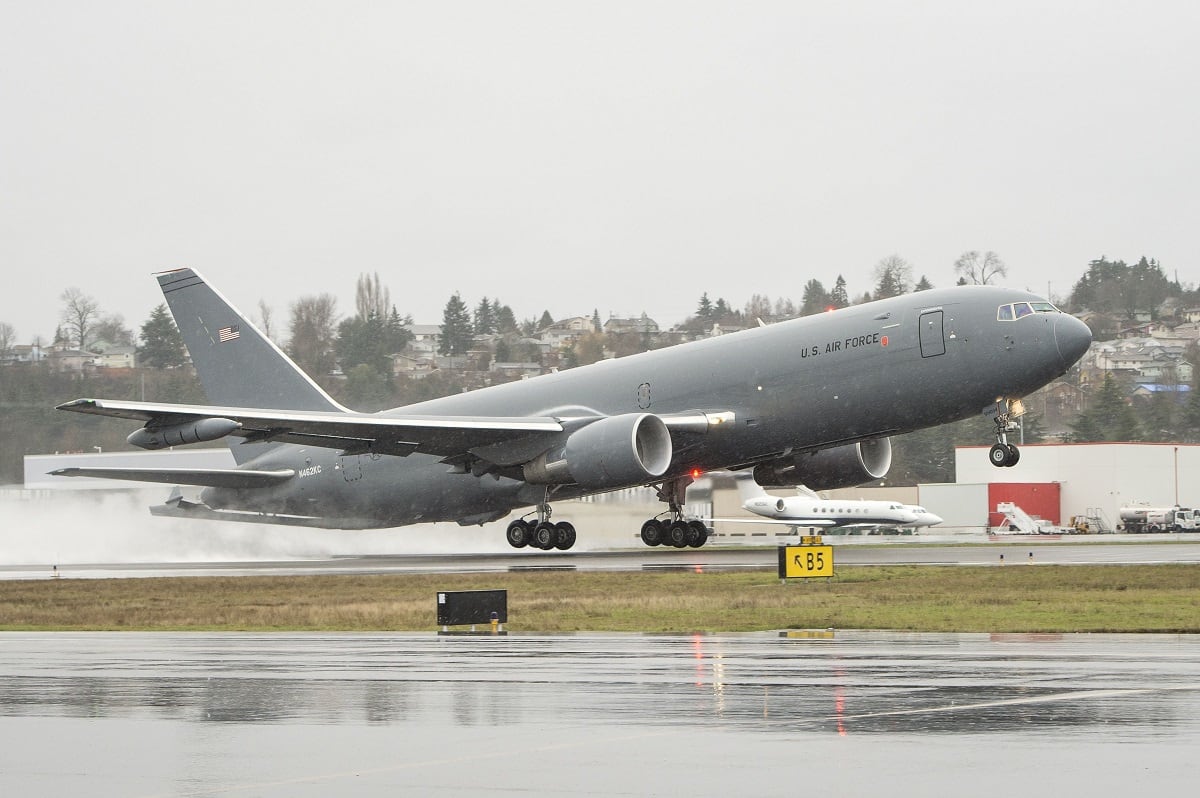Boeing's new KC-46A tanker completes first flight
By Ed Adamczyk
Dec. 06, 2017

The first KC-46 tanker for the U.S. Air Force takes off from Paine Field in Everett, Wash., on its maiden flight Tuesday. Photo by Marian Lockhart/Boeing
The first Boeing KC-46A tanker plane, expected to be delivered to the U.S. Air Force next year, completed its first flight, the company has announced.
The three-and-a-half-hour flight on Tuesday was called a success by Boeing and Air Force officials.
"Today's flight is another milestone for the Air Force/Boeing team and helps move us closer to delivering operational aircraft to the warfighter," Col. John Newberry, U.S. Air Force KC-46 System program manager, said in a press release.
Test pilots took the tanker to 39,000 feet and performed operational checks on its systems before landing more than three hours later. The aircraft tested Tuesday is the seventh built as part of the KC-46 program, with the previous six being used for testing and certification.
The plane, a modification of Boeing's 767 passenger plane, carries fuel and will be used to refuel fighter jets and other aircraft in mid-air. The company has a contract for the first 34, a $44.5 billion project, of what are anticipated to be 179 planes for the U.S. military.
Boeing announced Tuesday that it will miss its deadline to deliver the first plane to the U.S. Air Force by Dec. 31.
The contract calls for 18 KC-46A planes to be delivered by October 2018, a deadline 14 months later than originally planned. The most serious of three recent flaws seen in the plane is multiple incidents of its retractable boom scraping the aircraft receiving fuel during aerial refueling, Bloomberg News reported on Sunday.
https://www.upi.com/Defense-News/20...r-completes-first-flight/3291512577688/?nll=1
By Ed Adamczyk
Dec. 06, 2017
The first KC-46 tanker for the U.S. Air Force takes off from Paine Field in Everett, Wash., on its maiden flight Tuesday. Photo by Marian Lockhart/Boeing
The first Boeing KC-46A tanker plane, expected to be delivered to the U.S. Air Force next year, completed its first flight, the company has announced.
The three-and-a-half-hour flight on Tuesday was called a success by Boeing and Air Force officials.
"Today's flight is another milestone for the Air Force/Boeing team and helps move us closer to delivering operational aircraft to the warfighter," Col. John Newberry, U.S. Air Force KC-46 System program manager, said in a press release.
Test pilots took the tanker to 39,000 feet and performed operational checks on its systems before landing more than three hours later. The aircraft tested Tuesday is the seventh built as part of the KC-46 program, with the previous six being used for testing and certification.
The plane, a modification of Boeing's 767 passenger plane, carries fuel and will be used to refuel fighter jets and other aircraft in mid-air. The company has a contract for the first 34, a $44.5 billion project, of what are anticipated to be 179 planes for the U.S. military.
Boeing announced Tuesday that it will miss its deadline to deliver the first plane to the U.S. Air Force by Dec. 31.
The contract calls for 18 KC-46A planes to be delivered by October 2018, a deadline 14 months later than originally planned. The most serious of three recent flaws seen in the plane is multiple incidents of its retractable boom scraping the aircraft receiving fuel during aerial refueling, Bloomberg News reported on Sunday.
https://www.upi.com/Defense-News/20...r-completes-first-flight/3291512577688/?nll=1

